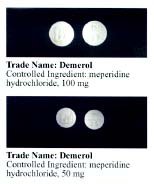|
Pethidine Intermediate A
Pethidine intermediate A is a 4-phenylpiperidine derivative that is a Precursor (chemistry), precursor to the opioid analgesic drug pethidine (meperidine). It is not known to have any analgesic activity in its own right, however other derivatives of pethidine with a 4-cyano group in place of the carboxylate ethyl ester have been found to be active, so pethidine intermediate A might also show opioid effects. It is scheduled by United Nations, UN Single Convention on Narcotic Drugs. It is a Schedule II Narcotic controlled substance in the United States and has an ACSCN of 9232. The 2014 annual manufacturing quota was 6 grammes (as an end product, presumably for research use). See also * Moramide intermediate * Methadone intermediate * Pethidine intermediate B (norpethidine) * Pethidine intermediate C (pethidinic acid) References {{Reflist, 2 Synthetic opioids 4-Phenylpiperidines Nitriles ... [...More Info...] [...Related Items...] OR: [Wikipedia] [Google] [Baidu] |
Phenyl
In organic chemistry, the phenyl group, or phenyl ring, is a cyclic group of atoms with the formula C6 H5, and is often represented by the symbol Ph. Phenyl group is closely related to benzene and can be viewed as a benzene ring, minus a hydrogen, which may be replaced by some other element or compound to serve as a functional group. Phenyl group has six carbon atoms bonded together in a hexagonal planar ring, five of which are bonded to individual hydrogen atoms, with the remaining carbon bonded to a substituent. Phenyl groups are commonplace in organic chemistry. Although often depicted with alternating double and single bonds, phenyl group is chemically aromatic and has equal bond lengths between carbon atoms in the ring. Nomenclature Usually, a "phenyl group" is synonymous with C6H5− and is represented by the symbol Ph or, archaically, Φ. Benzene is sometimes denoted as PhH. Phenyl groups are generally attached to other atoms or groups. For example, triphenylmethane (Ph3 ... [...More Info...] [...Related Items...] OR: [Wikipedia] [Google] [Baidu] |
Piperidine
Piperidine is an organic compound with the molecular formula (CH2)5NH. This heterocyclic compound, heterocyclic amine consists of a six-membered ring containing five methylene bridges (–CH2–) and one amine bridge (–NH–). It is a colorless liquid with an odor described as objectionable, and typical of amines. The name comes from the genus name ''Piper (genus), Piper'', which is the Latin word for Black pepper, pepper. Although piperidine is a common organic compound, it is best known as a representative structure element within many pharmaceuticals and alkaloids, such as natural-occurring Solenopsin, solenopsins. Production Piperidine was first reported in 1850 by the Scottish chemist Thomas Anderson (chemist), Thomas Anderson and again, independently, in 1852 by the French chemist Auguste André Thomas Cahours, Auguste Cahours, who named it. Both of them obtained piperidine by reacting piperine with nitric acid. Industrially, piperidine is produced by the hydrogenation o ... [...More Info...] [...Related Items...] OR: [Wikipedia] [Google] [Baidu] |
Precursor (chemistry)
In chemistry, a precursor is a compound that participates in a chemical reaction that produces another compound. In biochemistry, the term "precursor" often refers more specifically to a chemical compound preceding another in a metabolic pathway, such as a protein precursor. Illicit drug precursors In 1988, the United Nations Convention Against Illicit Traffic in Narcotic Drugs and Psychotropic Substances introduced detailed provisions and requirements relating the control of precursors used to produce drugs of abuse. In Europe the Regulation (EC) No. 273/2004 of the European Parliament and of the Council on drug precursors was adopted on 11 February 2004. ( European law on drug precursors) Illicit explosives precursors On January 15, 2013, the Regulation (EU) No. 98/2013 of the European Parliament and of the Council on the marketing and use of explosives precursors was adopted. The Regulation harmonises rules across Europe on the making available, introduction, possession and u ... [...More Info...] [...Related Items...] OR: [Wikipedia] [Google] [Baidu] |
Opioid
Opioids are substances that act on opioid receptors to produce morphine-like effects. Medically they are primarily used for pain relief, including anesthesia. Other medical uses include suppression of diarrhea, replacement therapy for opioid use disorder, reversing opioid overdose, and suppressing cough. Extremely potent opioids such as carfentanil are approved only for veterinary use. Opioids are also frequently used non-medically for their euphoric effects or to prevent withdrawal. Opioids can cause death and have been used for executions in the United States. Side effects of opioids may include itchiness, sedation, nausea, respiratory depression, constipation, and euphoria. Long-term use can cause tolerance, meaning that increased doses are required to achieve the same effect, and physical dependence, meaning that abruptly discontinuing the drug leads to unpleasant withdrawal symptoms. The euphoria attracts recreational use, and frequent, escalating recreational use of ... [...More Info...] [...Related Items...] OR: [Wikipedia] [Google] [Baidu] |
Analgesic
An analgesic drug, also called simply an analgesic (American English), analgaesic (British English), pain reliever, or painkiller, is any member of the group of drugs used to achieve relief from pain (that is, analgesia or pain management). It is typically used to induce cooperation with a medical procedure. Analgesics are conceptually distinct from anesthetics, which temporarily reduce, and in some instances eliminate, sensation, although analgesia and anesthesia are neurophysiologically overlapping and thus various drugs have both analgesic and anesthetic effects. Analgesic choice is also determined by the type of pain: For neuropathic pain, traditional analgesics are less effective, and there is often benefit from classes of drugs that are not normally considered analgesics, such as tricyclic antidepressants and anticonvulsants. Various analgesics, such as many NSAIDs, are available over the counter in most countries, whereas various others are prescription drugs owing ... [...More Info...] [...Related Items...] OR: [Wikipedia] [Google] [Baidu] |
Pethidine
Pethidine, also known as meperidine and sold under the brand name Demerol among others, is a synthetic opioid analgesic, pain medication of the phenylpiperidine class. Synthesized in 1938 as a potential anticholinergic agent by the German chemist Otto Eisleb, its analgesic properties were first recognized by Otto Schaumann while working for IG Farben, Germany. Pethidine is the prototype of a large family of analgesics including the pethidine 4-phenylpiperidines (piminodine, anileridine and others), the prodines (alphaprodine, MPPP, ''etc.''), bemidones (ketobemidone, etc.) and others more distant, including diphenoxylate and analogues. Pethidine is indicated for the treatment of moderate to severe pain, and is delivered as a hydrochloride salt in tablets, as a syrup, or by intramuscular, Subcutaneous injection, subcutaneous, or intravenous injection. For much of the 20th century, pethidine was the opioid of choice for many physicians; in 1975, 60% of doctors prescribed it for acu ... [...More Info...] [...Related Items...] OR: [Wikipedia] [Google] [Baidu] |
United Nations
The United Nations (UN) is an intergovernmental organization whose stated purposes are to maintain international peace and international security, security, develop friendly relations among nations, achieve international cooperation, and be a centre for harmonizing the actions of nations. It is the world's largest and most familiar international organization. The UN is headquarters of the United Nations, headquartered on extraterritoriality, international territory in New York City, and has other main offices in United Nations Office at Geneva, Geneva, United Nations Office at Nairobi, Nairobi, United Nations Office at Vienna, Vienna, and Peace Palace, The Hague (home to the International Court of Justice). The UN was established after World War II with Dumbarton Oaks Conference, the aim of preventing future world wars, succeeding the League of Nations, which was characterized as ineffective. On 25 April 1945, 50 governments met in San Francisco for United Nations Conference ... [...More Info...] [...Related Items...] OR: [Wikipedia] [Google] [Baidu] |
Single Convention On Narcotic Drugs
The Single Convention on Narcotic Drugs, 1961 (Single Convention, 1961 Convention, or C61) is an international treaty that controls activities (cultivation, production, supply, trade, transport) of specific narcotic drugs and lays down a system of regulations (licenses, measures for treatment, research, etc.) for their medical and scientific uses; it also establishes the International Narcotics Control Board. The Single Convention was adopted in 1961 and amended in 1972. As of 2022, the Single Convention as amended has been ratified by 186 countries. The convention has since been supplemented by the 1971 Convention on Psychotropic Substances, which controls LSD, MDMA, and other psychoactive pharmaceuticals, and the 1988 United Nations Convention Against Illicit Traffic in Narcotic Drugs and Psychotropic Substances. Ratification The Single Convention as amended in 1972 had been ratified or acceded to by 186 states. Only Chad remained party to the original 1961 Convention ... [...More Info...] [...Related Items...] OR: [Wikipedia] [Google] [Baidu] |
Moramide Intermediate
Moramide intermediate (3-methyl-4-morpholin-4-yl-2,2-diphenylbutanoic acid, on International Narcotics Control Board, INCB Yellow List as 2-methyl-3-morpholino-1,1-diphenylpropane carboxylic acid) is a moramide precursor scheduled by United Nations, UN Single Convention on Narcotic Drugs. In the United States, moramide intermediate is designated as a Schedule II controlled substance, and has an ACSCN of 9802. The 2014 annual manufacturing quota was nil. See also * Moramide * Methadone intermediate * Pethidine intermediate A * Pethidine intermediate B (norpethidine) * Pethidine intermediate C (pethidinic acid) References Analgesics 4-Morpholinyl compunds {{organic-compound-stub ... [...More Info...] [...Related Items...] OR: [Wikipedia] [Google] [Baidu] |
Methadone Intermediate
Methadone intermediate is a methadone precursor scheduled by UN Single Convention on Narcotic Drugs. It is a Schedule II Narcotic controlled substance in the United States and has an ACSCN of 9254. The 2014 annual manufacturing quota was 32 875 kilos.http://www.deadiversion.usdoj.gov/quotas/conv_factor/index.html See also * Moramide intermediate * Pethidine intermediate A * Pethidine intermediate B (norpethidine) * Pethidine intermediate C Pethidinic acid (meperidinic acid, pethidine intermediate C) is a 4-phenylpiperidine derivative that is both a metabolite of and a precursor to pethidine (meperidine). It is scheduled by UN Single Convention on Narcotic Drugs. It is a Schedule ... (pethidinic acid) References Synthetic opioids Drug rehabilitation Dimethylamino compounds {{analgesic-stub ... [...More Info...] [...Related Items...] OR: [Wikipedia] [Google] [Baidu] |
Pethidine Intermediate B
Norpethidine (normeperidine, pethidine intermediate B) is a 4-phenylpiperidine derivative that is both a precursor to, and the toxic metabolite of, pethidine (meperidine). It is scheduled by UN Single Convention on Narcotic Drugs. It is a Schedule II Narcotic controlled substance in the United States and has an ACSCN of 9233. The 2014 annual manufacturing quota was . Norpethidine is a controlled drug because of its potential uses in manufacturing both pethidine itself and a range of ''N''-substituted derivatives, but it has little opioid activity in its own right. Instead, norpethidine acts as a stimulant and causes convulsions. Bioaccumulation of norpethidine is a major complication when pethidine is used in medicine as an analgesic, as when pethidine is used in high doses or administered by intravenous infusion, norpethidine can accumulate in the body at a faster rate than it is being excreted, particularly in elderly patients or those with compromised liver or kidney fun ... [...More Info...] [...Related Items...] OR: [Wikipedia] [Google] [Baidu] |
Pethidine Intermediate C
Pethidinic acid (meperidinic acid, pethidine intermediate C) is a 4-phenylpiperidine derivative that is both a metabolite of and a precursor to pethidine (meperidine). It is scheduled by UN Single Convention on Narcotic Drugs. It is a Schedule II Narcotic controlled substance in the United States and has an ACSCN of 9234. The 2014 annual manufacturing quota was 6 grams. Pethidinic acid is a controlled drug because of its potential uses in manufacturing both pethidine itself and some of its substituted derivatives, but it has little opioid activity in its own right. Metabolism of pethidine to pethidinic acid is carried out mainly by the carboxylesterase enzyme hCE-1 in the liver, and since the activity of this enzyme can vary between individuals, the rate and extent of pethidinic acid production can vary. Frank Wätjen used pethidinic acid as a precursor chemical to a heterocyclic moiety. See also * Moramide intermediate * Methadone intermediate * Pethidine intermediate A * P ... [...More Info...] [...Related Items...] OR: [Wikipedia] [Google] [Baidu] |





